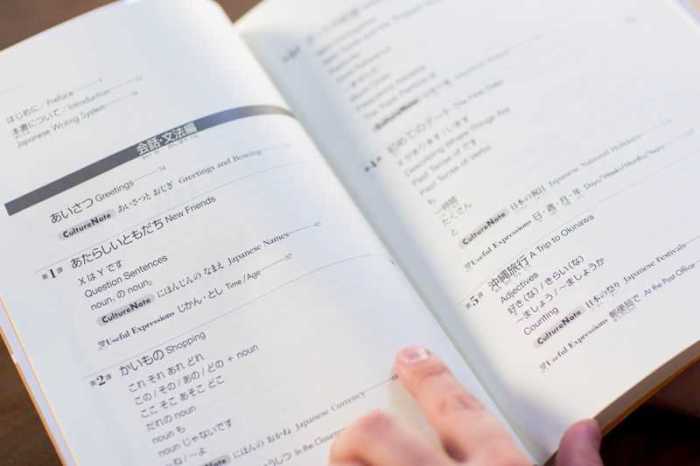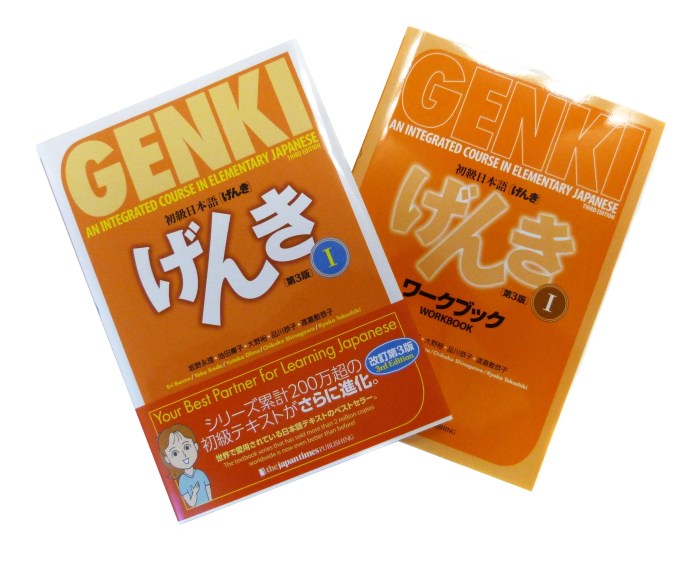Genki 2 workbook answers 3rd edition – The Genki II Workbook 3rd Edition stands as an indispensable resource for Japanese language learners, offering a comprehensive and engaging approach to developing proficiency in all aspects of the language.
With its clear explanations, diverse exercises, and immersive cultural insights, this workbook empowers students to achieve fluency in reading, writing, speaking, and listening.
Genki II Workbook 3rd Edition Overview

The Genki II Workbook 3rd Edition is a comprehensive companion to the Genki II textbook, designed to enhance students’ proficiency in Japanese language skills. It provides a wide range of exercises, activities, and supplementary materials to reinforce the concepts and grammatical structures introduced in the textbook.
The workbook is organized into 24 chapters, each corresponding to a chapter in the textbook. Each chapter is further divided into sections, which typically include exercises on grammar, vocabulary, reading comprehension, and writing. The exercises are carefully sequenced and designed to build upon the knowledge and skills acquired in previous sections.
Learning Objectives and Goals
The primary learning objective of the Genki II Workbook is to develop students’ proficiency in Japanese language skills. The exercises and activities in the workbook focus on the following key areas:
- Grammar: The workbook provides ample practice opportunities for students to master Japanese grammar structures, including sentence patterns, verb conjugations, and particle usage.
- Vocabulary: The exercises help students expand their vocabulary and learn new words and phrases related to various topics.
- Reading Comprehension: The workbook includes a variety of reading passages to enhance students’ reading comprehension skills and expose them to authentic Japanese texts.
- Writing: The workbook includes exercises that encourage students to practice writing in Japanese, including short compositions and dialogues.
By completing the exercises and activities in the Genki II Workbook, students can reinforce their understanding of the material covered in the textbook and develop a solid foundation in Japanese language skills.
Content Analysis of Exercises

The Genki II Workbook 3rd Edition offers a comprehensive range of exercises designed to reinforce and expand students’ Japanese language skills. These exercises are meticulously categorized based on their specific purpose, ensuring a well-rounded approach to language learning.The workbook features a diverse array of exercises, including:
Grammar Practice, Genki 2 workbook answers 3rd edition
- Fill-in-the-blank exercises challenge students to apply grammatical concepts in context.
- Sentence-completion exercises test students’ understanding of sentence structure and grammar rules.
- Translation exercises enhance students’ ability to express ideas in both Japanese and English.
Vocabulary Building
- Matching exercises help students associate new words with their meanings.
- Fill-in-the-blank exercises reinforce vocabulary acquisition through context-based practice.
- Word puzzles, such as crosswords and word searches, provide an engaging way to expand vocabulary.
Kanji Recognition
- Stroke order exercises guide students in writing kanji characters correctly.
- Kanji matching exercises test students’ ability to recognize and match kanji to their meanings.
- Kanji writing exercises challenge students to produce kanji characters from memory.
The difficulty level of the exercises progresses gradually throughout the workbook, catering to students with varying levels of proficiency. Initial exercises provide a gentle introduction to new concepts, while later exercises present more complex challenges, ensuring continuous growth and development of language skills.
Grammar Explanations and Examples

The Genki II Workbook 3rd Edition presents grammar concepts clearly and effectively, providing numerous opportunities for practice. Grammar explanations are concise and well-organized, with clear examples illustrating the usage of grammatical structures.
Introduction of Grammar Rules
New grammar rules are introduced through short, focused lessons that break down complex concepts into manageable chunks. Each lesson begins with a brief overview of the grammar point, followed by clear explanations and examples.
For example, the lesson on the passive voice introduces the concept with a simple definition and an example:
Passive voice:When the subject of a sentence is acted upon by the verb.
Example: The book was read by me.
Reinforcement through Exercises
After each grammar explanation, the workbook provides ample exercises to reinforce the concept. These exercises vary in difficulty, allowing students to gradually build their understanding and proficiency.
The exercises include:
- Fill-in-the-blank exercises to test comprehension of grammar rules
- Sentence transformation exercises to practice applying grammar rules in context
- Short writing exercises to encourage students to produce sentences using the target grammar
By providing a variety of exercises, the workbook ensures that students have multiple opportunities to practice and master the grammar concepts.
Strengths and Weaknesses
Strengths:
- Clear and concise grammar explanations
- Well-organized lessons with logical progression
- Ample exercises for practice and reinforcement
Weaknesses:
- Some explanations could be more detailed for advanced learners
- Some exercises may be too repetitive for some students
Vocabulary Building Strategies: Genki 2 Workbook Answers 3rd Edition

The Genki II Workbook 3rd Edition employs various strategies to introduce and reinforce new vocabulary effectively. These methods facilitate active recall and retention, promoting long-term memory of new words.
Flashcards
Flashcards are a traditional and effective vocabulary-building tool utilized in the Genki II Workbook. They present new words on one side and their translations or definitions on the other. Regular practice with flashcards encourages active recall, as learners attempt to retrieve the meaning of the word from memory.
The spaced repetition technique, where flashcards are reviewed at increasing intervals, enhances retention and prevents forgetting.
Repetition Exercises
The workbook incorporates numerous repetition exercises that expose learners to new vocabulary repeatedly. These exercises include fill-in-the-blank, matching, and translation tasks. By encountering the same words in different contexts, learners strengthen their memory and improve their ability to recall and use the words accurately.
Context-Based Learning
The Genki II Workbook presents new vocabulary within meaningful contexts, such as dialogues, stories, and cultural notes. This approach helps learners understand the usage and nuances of new words in real-world situations. By seeing how words are used in authentic contexts, learners can better grasp their meaning and apply them appropriately.
Active Recall and Retention
The workbook exercises are designed to promote active recall, which is essential for long-term retention. Learners are encouraged to actively retrieve information from memory rather than passively reading or listening. This process strengthens neural connections and improves the ability to access and use vocabulary in various contexts.
Kanji Practice and Recognition
The Genki II Workbook 3rd Edition introduces and practices kanji characters in a systematic and comprehensive manner. It employs a variety of methods to ensure effective memorization and proficiency in this essential aspect of Japanese language.
Teaching Methods
The workbook utilizes several methods to teach kanji characters effectively:
- Stroke Order:Kanji characters are presented with clear and detailed stroke order diagrams, guiding learners in the correct sequence of strokes for each character.
- Pronunciation:Pronunciation guides accompany each kanji, providing both the on’yomi (Chinese-derived) and kun’yomi (native Japanese) readings.
- Meaning:Each kanji is accompanied by its meaning and usage in context, fostering understanding and application in real-life scenarios.
Exercises and Activities
The workbook incorporates a wide range of exercises and activities to reinforce kanji recognition and writing skills:
- Kanji Recognition Exercises:Learners are presented with a variety of exercises, such as matching games and fill-in-the-blank activities, to test their ability to recognize kanji characters.
- Kanji Writing Exercises:Learners practice writing kanji characters in a dedicated section of the workbook, with ample space provided for multiple attempts and reinforcement of proper stroke order.
- Contextualized Kanji Usage:The workbook includes exercises that require learners to use kanji characters in context, fostering comprehension and application in real-life scenarios.
Through these methods and exercises, the Genki II Workbook 3rd Edition provides a comprehensive and effective approach to kanji practice and recognition, equipping learners with the skills necessary for proficiency in Japanese language.
Cultural Insights and Applications
The Genki II Workbook 3rd Edition seamlessly integrates cultural insights and real-life applications into its exercises, enhancing the learning experience and fostering a deeper understanding of Japanese culture.
Cultural notes, examples, and scenarios are meticulously incorporated throughout the workbook, providing context and enriching students’ cultural knowledge. These elements create an immersive and engaging learning environment, allowing students to connect with the language in a meaningful way.
Cultural Notes
The workbook includes numerous cultural notes that provide valuable insights into Japanese customs, traditions, and etiquette. These notes cover a wide range of topics, such as:
- Greetings and salutations
- Dining customs
- Gift-giving practices
- Social interactions
- Historical and cultural landmarks
Real-Life Applications
The exercises in the workbook often incorporate real-life scenarios that simulate everyday situations in Japan. These scenarios encourage students to apply their language skills in practical contexts, such as:
- Ordering food at a restaurant
- Asking for directions
- Making appointments
- Participating in social gatherings
- Shopping for goods and services
Immersive and Engaging Experience
By incorporating cultural insights and real-life applications, the Genki II Workbook 3rd Edition creates an immersive and engaging learning experience. These elements help students:
- Develop a deeper understanding of Japanese culture
- Build confidence in using the language in real-world situations
- Foster a genuine interest in Japanese language and culture
- Prepare for future travel or interactions with Japanese speakers
Helpful Answers
Is the Genki II Workbook 3rd Edition suitable for beginners?
Yes, the workbook is designed for students with little to no prior knowledge of Japanese.
What types of exercises are included in the workbook?
The workbook features a variety of exercises, including grammar practice, vocabulary building, kanji recognition, and reading comprehension.
How does the workbook introduce and teach grammar concepts?
Grammar concepts are introduced through clear explanations and examples, followed by exercises that reinforce understanding and application.